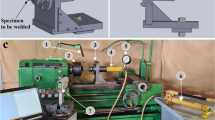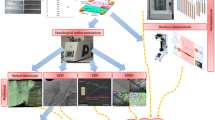Abstract
High rotational speed friction stir welding (FSW) was successfully employed to weld 6061-T6 aluminum alloy thin plates. The effect of high rotational speed and fast transverse speed on temperature distribution, microstructure evolution, and tensile properties of friction stir welded 6061-T6 joints was investigated in detail. The high rotational speed with fast transverse speed had a significant influence on the peak temperature in the nugget zone (NZ). Increasing the rotational speed and decreasing the transverse speed could obviously improve the peak temperature in the NZ, but exhibit little effect on the heat-affected zone under high rotational speed FSW. The NZ was characterized as a significant refinement of the equiaxed grain. The number of precipitates, subgrains, and low angle grain boundaries in the NZ of high rotational speed FSW joint increased significantly due to moderate heat input and strain rate. The weld zone was seriously softened at low rotational speed, whereas it was alleviated at high rotational speed and was affected slightly by rotational speed and transverse speed. The excellent mechanical properties of the friction stir welded 6061-T6 joints were obtained at a combination of high rotational speed and fast transverse speed. The maximum tensile strength reached 301.8 MPa, 85.8% of the base material.
Similar content being viewed by others
References
Miller WS, Zhuang L, Bottema J, Wittebrood AJ, De Smet P, Haszler A, Vieregge A (2000) Recent development in aluminium alloys for the automotive industry. Mater Sci Eng A 280:37–49
Çam G, İpekoğlu G (2017) Recent developments in joining of aluminum alloys. Int J Adv Manuf Technol 91:1851–1866
Zhan XH, Chen JC, Liu JJ, Wei YH, Zhou JJ, Meng Y (2016) Microstructure and magnesium burning loss behavior of AA6061 electron beam welding joints. Mater Des 99:449–458
Peng D, Shen J, Tang Q, Wu CP, Zhou YB (2013) Effects of aging treatment and heat input on the microstructures and mechanical properties of TIG-welded 6061-T6 alloy joints. Int J Min Met Mater 20:259–265
Scialpi A, De Filippis LAC, Cavaliere P (2007) Influence of shoulder geometry on microstructure and mechanical properties of friction stir welded 6082 aluminium alloy. Mater Des 28:1124–1129
Simar A, Bréchet Y, Meester BD, Denquin A, Gallais C, Pardoen T (2012) Integrated modeling of friction stir welding of 6xxx series Al alloys: process, microstructure and properties. Prog Mater Sci 57:95–183
Malopheyev S, Vysotskiy I, Kulitskiy V, Mironov S, Kaibyshev R (2016) Optimization of processing-microstructure-properties relationship in friction-stir welded 6061-T6 aluminum alloy. Mater Sci Eng A 662:136–143
Ramulu PJ, Narayanan RG, Kailas SV (2013) Forming limit investigation of friction stir welded sheets: influence of shoulder diameter and plunge depth. Int J Adv Manuf Technol 69:2757–2772
Ramulu PJ, Narayanan RG, Kailas SV, Reddy J (2013) Internal defect and process parameter analysis during friction stir welding of Al 6061 sheets. Int J Adv Manuf Technol 65:1515–1528
Li DX, Yang XQ, Cui L, He FZ, Shen H (2014) Effect of welding parameters on microstructure and mechanical properties of AA6061-T6 butt welded joints by stationary shoulder friction stir welding. Mater Des 64:251–260
Hou JC, Liu HJ, Zhao YQ (2014) Influences of rotation speed on microstructures and mechanical properties of 6061-T6 aluminum alloy joints fabricated by self-reacting friction stir welding tool. Int J Adv Manuf Technol 73:1073–1079
Liu FJ, Fu L, Chen HY (2017) Microstructures and mechanical properties of thin plate aluminum alloy joint prepared by high rotational speed friction stir welding. Acta Metall Sin 53(3):1651–1658
Liu HJ, Hou JC, Guo H (2013) Effect of welding speed on microstructure and mechanical properties of self-reacting friction stir welded 6061-T6 aluminum alloy. Mater Des 50:872–878
Forcellese A, Martarelli M, Simoncini M (2016) Effect of process parameters on vertical forces and temperatures developed during friction stir welding of magnesium alloys. Int J Adv Manuf Technol 85:595–604
Fehrenbacher A, Duffie NA, Ferrier NJ, Pfefferkorn FE, Zinn MR (2014) Effects of tool–workpiece interface temperature on weld quality and quality improvements through temperature control in friction stir welding. Int J Adv Manuf Technol 71:165–179
Woo W, Feng Z, Wang XL, Brown DW, Clausen B, An K, Choo H, Hubbard CR, David SA (2007) In situ neutron diffraction measurements of temperature and stresses during friction stir welding of 6061-T6 aluminium alloy. Sci Technol Weld Join 12(4):298–303
Arbegast WJ, Hartley PJ (1998) In: Proceedings of the fifth international conference on trends in welding research. Pine Mountain, GA, USA
Mishra RS, Komarasamy M (2016) Friction stir welding of high-strength 7XXX aluminum alloys. Denton, TX, USA
Arbegast WJ (2008) A flow-partitioned deformation zone model for defect formation during friction stir welding. Scr Mater 58:372–376
McQueen HJ, Blum W (2000) Dynamic recovery: sufficient mechanism in the hot deformation of Al (<99.99). Mater Sci Eng A 290:95–107
Kumar K, Kailas SV (2008) The role of friction stir welding tool on material flow and weld formation. Mater Sci Eng A 485:367–374
Liu FJ, Fu L, Chen HY (2017) Microstructure evolution and fracture behaviour of friction stir welded 6061-T6 thin plate joints under high rotational speed. Sci Technol Weld Join. https://doi.org/10.1080/13621718.2017.1389837
Hou JC, Liu HJ, Zhao YQ (2013) Influences of rotation speed on microstructures and mechanical properties of 6061-T6 aluminum alloy joints fabricated by self-reacting friction stir welding tool. Int J Adv Manuf Technol 73:1073–1079
Nourani M, Milani AS, Yannacopoulos S (2015) On experimental optimization of friction stir welding of aluminum 6061: understanding processing-microstructure-property relations. Int J Adv Manuf Technol 79:1425–1441
Woo WC, Balogh L, Ungár T, Choo H, Feng ZL (2008) Grain structure and dislocation density measurements in a friction-stir welded aluminum alloy using X-ray peak profile analysis. Mater Sci Eng A 498:308–313
Lim SG, Kim SS, Lee CG, Kim SJ (2004) Tensile behavior of friction-stir-welded al 6061-T651. Metall Mater Trans A 35:2829–2835
Simar A, Bréchet Y, de Meester B, Denquin A, Pardoen T (2007) Sequential modeling of local precipitation, strength and strain hardening in friction stir welds of an aluminum alloy 6005A-T6. Acta Mater 55:6133–6143
Luo J, Mei Z, Tian W, Wang ZR (2006) Diminishing of work hardening in electro formed polycrystalline copper with nano-sized and uf-sized twins. Mater Sci Eng A 441:282–290
Afrin N, Chen DL, Cao X, Jahazi M (2007) Strain hardening behavior of a friction stir welded magnesium alloy. Scr Mater 57:1004–1007
Chen XH, Lu L (2007) Work hardening of ultrafine-grained copper with nanoscale twins. Scr Mater 57:133–136
Funding
The work was supported by the National Natural Science Foundation of China (No. 51575450); the Key areas of innovation team in Shaanxi Province (No. 2014KCT-12); the Natural Science Foundation of Shaanxi Province (No. S2016YFJZ0164); and the Research Fund of the State Key Laboratory of Solidification Processing (No. 127-QP-2015).
Author information
Authors and Affiliations
Corresponding author
Rights and permissions
About this article
Cite this article
Liu, F.J., Fu, L. & Chen, H.Y. Effect of high rotational speed on temperature distribution, microstructure evolution, and mechanical properties of friction stir welded 6061-T6 thin plate joints. Int J Adv Manuf Technol 96, 1823–1833 (2018). https://doi.org/10.1007/s00170-018-1736-0
Received:
Accepted:
Published:
Issue Date:
DOI: https://doi.org/10.1007/s00170-018-1736-0




